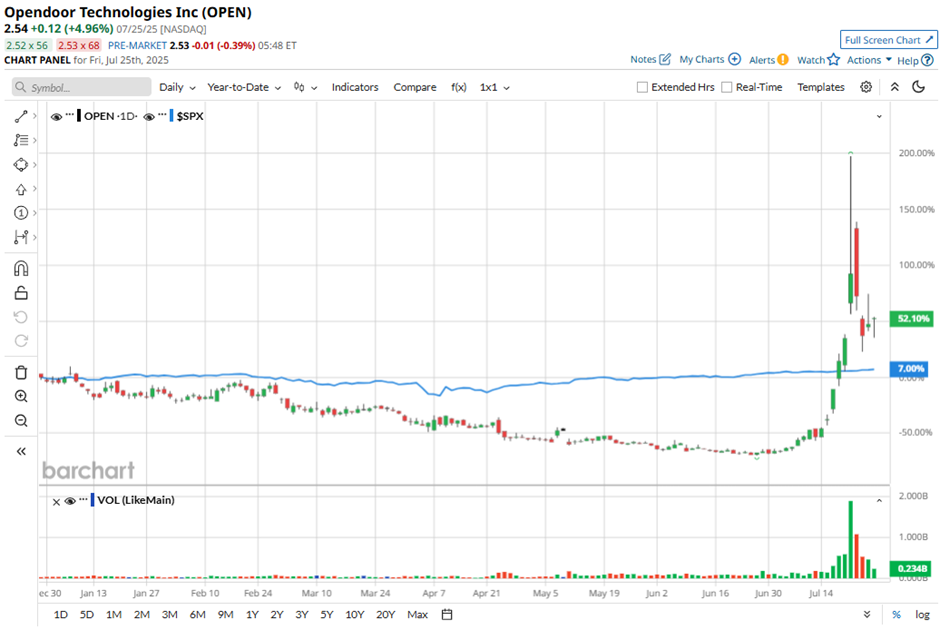Dear Opendoor Stock Fans, Mark Your Calendars for August 5

Opendoor Technologies (OPEN) has long been one of the market’s hardest-hit stocks. Once a standout during the pandemic housing boom, the online home-flipping company collapsed under the weight of rising interest rates and a frozen housing supply. Most homeowners are still locked into rock-bottom mortgage rates and have little incentive to sell, leaving Opendoor’s business model badly exposed. OPEN stock has nosedived 94% from its 2021 peak.
But 2025 brought a dramatic shift. In mid-July, hedge fund manager Eric Jackson, best-known for his early bullish call on Carvana (CVNA), publicly threw his support behind Opendoor on X. Citing deep cost cuts and long-term upside, Jackson’s endorsement lit a fire under OPEN stock and brought a wave of retail attention. What followed was a classic meme stock surge. Online forums lit up with Opendoor chatter, triggering a massive short squeeze as bearish traders rushed to cover their positions.
In the past month alone, OPEN stock has delivered a massive triple-digit return. But despite the surge, the company’s fundamentals remain largely unchanged. Opendoor is still a cash-burning, low-margin business with limited near-term growth. So, with its second-quarter earnings report around the corner, here’s a closer look at this name.
About Opendoor Stock
Opendoor is a leading digital platform for residential real estate transactions. Since 2014, the company has set out to become the Amazon (AMZN) of the housing market through iBuying, a model where homes are bought and resold via an online marketplace. Opendoor went public through a special purpose acquisition company (SPAC) merger in late 2020 and currently has a market capitalization of roughly $1.7 billion.
The stock has been in hot water for quite a while, but the recent meme frenzy, combined with hedge fund manager Eric Jackson’s vote of confidence, couldn’t have been better timed. In late May, the company was hit with a delisting warning from Nasdaq after its shares traded below $1 for 30 consecutive business days. With 180 days to regain compliance, Opendoor moved quickly, proposing a reverse stock split in early June that could boost its share price by as much as 50 times.
That being said, with the clock ticking, the sudden burst of investor enthusiasm couldn’t have landed at a more critical moment. After years of underperformance, the stock is now up 28% this year, easily outpacing the S&P 500 Index’s ($SPX) year-to-date (YTD) gain of 8%. Over the past month alone, OPEN shares have soared an eye-popping 267%, leaving the broader index’s 3% return in the dust.

Opendoor’s Q1 Earnings Beat and Q2 in Spotlight
On May 6, Opendoor released its fiscal 2025 first-quarter results, and the numbers came in stronger than Wall Street had anticipated. Revenue totaled $1.15 billion, down 2.4% from the same period last year but still comfortably above the consensus estimate of $1.06 billion. For a business built around iBuying — the practice of purchasing and reselling homes online — revenue can often look impressive even when profits don’t follow.
That’s why investors tend to look deeper, focusing more on profitability and cash flow than just the top line. In that regard, Opendoor showed encouraging signs of progress. The company trimmed its adjusted net loss by 21% to $63 million, while its net loss per share improved 25% to $0.12, beating analyst expectations of a $0.13 per-share loss.
More notably, Opendoor managed to cut its adjusted EBITDA loss to $30 million, a sharp improvement from the $50 million loss it reported a year ago. These numbers reflect ongoing efforts to rein in costs and streamline operations. Operational momentum also showed up in its home activity. The company purchased 3,609 homes during the quarter, a 4% increase from the first quarter of 2024 and a 22% jump sequentially.
As of quarter-end, Opendoor held $559 million in cash, providing it with some financial breathing room to support short-term operations. Looking ahead, Opendoor is scheduled to report its Q2 earnings after the market closes on Tuesday, Aug. 5. Management has guided for revenue in the range of $1.45 billion to $1.53 billion and expects contribution profit to land between $65 million and $75 million.
Analysts, meanwhile, forecast a significant improvement in the bottom line, with a projected Q2 net loss per share of just $0.04 representing a 56% annual improvement. For the full fiscal year, losses are expected to narrow by 55% to $0.24 per share, and further shrink to a $0.23 loss in fiscal 2026, signaling a gradual path toward stability.
What Do Analysts Expect for Opendoor Stock?
As the countdown to Opendoor’s Q2 earnings ticks on, Wall Street is treading carefully. OPEN stock holds a consensus “Hold” rating, underscoring a wait-and-see approach. Of the 10 analysts covering the name, only one is all-in with a “Strong Buy,” seven play it safe with a “Hold,” one suggests a “Moderate Sell,” and the remaining analyst sounds the alarm with a “Strong Sell.” Currently, the stock trades at a premium to its average analyst price target of $1.14.

On the date of publication, Anushka Mukherji did not have (either directly or indirectly) positions in any of the securities mentioned in this article. All information and data in this article is solely for informational purposes. For more information please view the Barchart Disclosure Policy here.